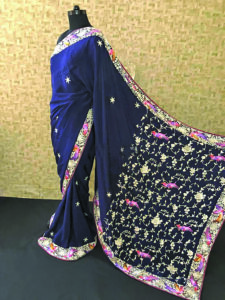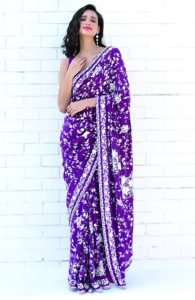 The legacy of the Parsi Gara is as incredible as the fabric and work that an original Gara displays. It is believed, that the gorgeous Parsi Gara embroidery can be traced as far back as 650 A.D., when
The legacy of the Parsi Gara is as incredible as the fabric and work that an original Gara displays. It is believed, that the gorgeous Parsi Gara embroidery can be traced as far back as 650 A.D., when Persian women were completely fascinated by it. Almost all traditional textiles and art forms give us a hint about history, the region they come from, the culture and the art they adopted. More often than not, they reveal a story that is deeper and more meaningful. The Parsi Gara is one such garment as well. It hides within its folds, the story of voyages at sea, the old trading routes and the tale of the rise of India’s most unique and extraordinary community.
Persian women were completely fascinated by it. Almost all traditional textiles and art forms give us a hint about history, the region they come from, the culture and the art they adopted. More often than not, they reveal a story that is deeper and more meaningful. The Parsi Gara is one such garment as well. It hides within its folds, the story of voyages at sea, the old trading routes and the tale of the rise of India’s most unique and extraordinary community.
Viewed as an heirloom, the Parsi Gara is a revered piece of clothing handed down from one generation to the next. The timeless elegance of a traditional Parsi Gara is undeniable. Predominantly worn by the Parsi community during weddings and special occasions, it has gained favour as a unique and desired member in the exhaustive variety of crafts and handlooms found in our country. Today, a Gara, is a rich, beautiful, embroidered piece of divinity and a favorite among many even outside the community.
The Gara embroidery came into our design lexicon at the time when India traded with China. They carried opium and cotton from India, which was bartered for tea, in China. Tea, as a commodity, was gaining favour in Europe and was in demand by the British. It was the Parsis who began trading with the British at the time. When they returned, their ships brought back exquisite ceramics and antiques that were readily available in China.
Legend says, that fabric with a new kind of embroidery was also brought back by one of the traders. The fabric and the work, which had such authentic depictions of flora and fauna targeted for the European markets, found instead, a place in the Parsi community, which had newly settled in Bombay. The ladies of this erstwhile, rich trading community were looking for just something special. The vibrant colours and gorgeous embroidery soon caught their eye. It became incredibly beloved in a short span of time. The women wanted a certain new look and they adopted the Gara and made it to their liking, as a sari. It soon became their signature and fashion statement.
A Gara is a Sari which is covered in silk thread embroidery. The motifs of this embroidery are varied. The originals depicted Chinese men and women, called the ‘Cheena-Cheeni Gara’. These patterns mainly had beautiful depictions and motifs of pagodas, bridges, plantations, and people doing daily chores in China. The original designs that were brought back at that time, soon became prized possessions. I wonder how many original pieces survived or still remain. An original Gara in good condition is priceless and worth its weight in gold, literally! Embroidery also varied from flora and bird, the Marga–Margi rooster and a hen, the Chakla–Chakli depicting the male and female sparrow; to polka dotted motifs called kaada-papeta (onions and potatoes).
Though the Sari is covered in silk thread embroidery, it retains a nice flow and can be draped easily. The original fabric was called the ‘Sali Ghaj’, which had just thin lines running through it. Original Garas had embroidery all over and this made the fabric stretch and give way, from time to time. The community always boasted skilled artisans who could restore, transfer and repair these heirlooms in masterful ways. And thus, survived these splendid pieces!
Over the years, the Gara lost its appeal and charm, especially with the new generation who felt the saris were too heavy and cumbersome to manage. This was a time where light fabrics, like chiffon and georgette, gained favour. The trends leaned towards the flimsy appeal of saris worn by Bollywood stars and newer materials like crepe d chine. Even though its popularity waned, the Parsi Gara achieved heirloom status.
Amongst Parsis, you could still see the occasional Gara being aired at special occasions that demanded tasteful elegance. With the passage of time, the heavy sari-borders (or ‘kor’) gave way to lighter versions, adding to the sophistication quotient. The young ones, not to be outdone, adopted the kors and wore a simplified Gara, with less embroidery work.
The 80’s witnessed a revival of this ageless garment. A lot of community members, who were not bequeathed this heirloom, now found solace in the fact that Garas were being made in Mumbai by a couple of people who had learned the intricate secrets and the original craftsmanship of these garments. Of course, these came at a price. Soon, with the advent of machine worked Garas, every member flaunted a Gara! Weavers even translated the embroideries into materials, such as georgette and chiffon! To the discerning eye, the difference between a hand embroidered piece and one done on a machine, is glaringly noticeable and shockingly insulting. But now, for a community that suddenly fell in love with these saris again, the price point made all the difference… even if it was just a poor copy of the original.
Increasingly, there is a growing excitement and interest in the younger generation, with Parsi girls opting for a Gara in their wardrobe. Even non-Parsi girls, marrying into the community, insist on a Gara, as part of their trousseau. Everyone now appreciates and values the time-tested, agelessness of this wonderful garment and craft. The Gara is nothing short of poetry on fabric. It is a classic aria on silk. It is an investment of sorts – a gift for the younger generation.
Retaining its original elegance, the Gara is now being adapted to suit a modern context to please a younger audience. If you are lucky to have an heirloom in your possession, keep it well. In your hands is entrusted the history and a legacy that needs appreciation, pride and looking after.
- Navroz – A New Year, A New Beginning! - 15 March2025
- Women Are Simply Awesome! - 8 March2025
- Romantic Love – Win Some, Lose Some! - 8 February2025
